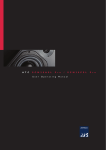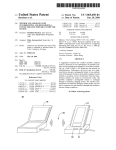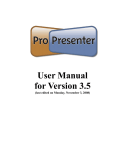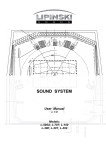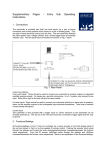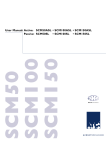Download SCM7 (6p) Rev D
Transcript
SCM7 User Manual: SCM7 Passive M U LT I C H A N N E L ® AC O U S T I C ENGINEERS SCM7 Passive Introduction Welcome. In selecting ATC you have chosen an ATC was founded in London in 1974 by Australian emigre Bill Woodman, who still example of the finest audio engineering heads the company today. An enthusiastic pianist and engineer he was naturally available. ATC was founded on a principle of drawn to loudspeaker design and after a period working at Goodmans, where many engineering excellence, and that principle still of the names that went on to found British loudspeaker companies began their defines our products today. Given the right careers, he struck out on his own.The premise on which ATC began is a simple one, opportunities, ATC products will deliver exceptional audio performance, but the opportunities will only arise from careful and thoughtful installation and use. Please read the and one that in many respects is still true today: hi-fi loudspeakers tend to be detailed and accurate but of limited dynamic range, while professional monitor speakers tend to express the opposite character. ATC products were designed from the outset to offer the best of both. It’s an easy concept to describe, but surprisingly difficult to engineer. following manual fully. It will help you understand the product and to realise its full potential. We are happy to answer questions and offer advice on any issues that arise through installation or use of ATC products. Contact details can be found at the back of this manual. The difficulty inherent in designing such loudspeakers is one of scale. Hi-fi levels of accuracy and detail call for lightweight moving parts and delicate engineering. Professional monitor levels of performance however demand far more robust components engineered to survive the rigours of high level use for extended periods.The only way to combine the two is through precision engineering of a class and scale more often associated with aerospace or motorsport. But the results are worth the effort and the cost. ATC loudspeakers, with their unique in-house designed drivers, combine the best of hi-fi and professional to devastating effect. ATC has become synonymous with active systems. Choosing to offer active loudspeakers (where the passive crossover network is replaced by active filters and multiple power amplifiers) is simply a result of the uncompromising attitude to loudspeaker design.While passive systems still have their place, and ATC engineering skills can still bring remarkable results from them,“active” is a fundamentally better solution to the problems posed by accurate, high level music reproduction.The ATC instinct is always for the better solution. Not cheaper, not quicker, but better. It was the development of active loudspeakers that first brought ATC into electronics design and engineering. Active speakers demand multiple power amplifiers so ATC from the mid 1980s became not just a loudspeaker manufacturing company but an electronics manufacturer too.The further step from electronics for active speakers to a range of stand-alone amplifier products was natural and now means that ATC engineering is available from the recording desk or CD player output to the ears. From modest beginnings ATC has grown to become one of the very few manufacturers successful across both domestic and professional audio. By selecting ATC you join a group of music lovers, professional audio engineers, studios and musicians across the World that understand and value the engineering that goes into an ATC product - and the sound that comes out. SCM7 Passive 1. Monitor Placement The subjective performance of any monitor loudspeaker will be fundamentally influenced by the acoustic character of the room in which it is used, and its position within the room. Most often monitors are installed in rooms which are comfortable to sit and talk in.A mixture of carpets, curtains and soft furnishings will help ensure that middle and high frequencies are reasonably well controlled.There may however be low frequency problems; either too much or too little bass. To minimise low frequency problems the monitors should be kept away from corners or walls. Start with them positioned around 1 metre from the side walls and 2 metres from the back. If the balance is bass-light, the monitors can be moved towards the back walls. All rooms vary and it is a good idea to experiment with both the listening and speaker position until a good compromise is reached. For professional installations the requirements are often very specific. Please consult with an experienced professional acoustician if necessary. 2. Amplification The choice of partnering amplifier for the SCM7 will have significant influence on the performance of the system. Consider the following when selecting the amplifier: • With any passive loudspeaker there is a trade-off between low frequency extension and sensitivity.The SCM7’s extended low frequency response means that its sensitivity is relatively low. It is advisable therefore to select an amplifier of relatively high power capabilities. Use of an under specified amplifier will result in the system sounding distorted at high levels and may risk damage. Valve or solid state amplifiers with high output impedance should be auditioned carefully to establish that their characteristic reduced damping at low frequencies is acceptable. • The SCM7 bass/mid driver voice coil is an unusually large 45mm and operates in an overhung gap.The result is that the SCM7 not only demonstrates extremely low distortion at all levels but also a greatly enhanced effective dynamic range. This exceptional distortion performance, also combined with very wide dispersion, will ruthlessly reveal deficiencies in ancillary equipment. It is advisable therefore to audition the SCM7 with your proposed amplifier and ancillary system. 3. Connection The SCM7 is equipped with a “bi-wire” connection panel that enables separate amplification of the bass/mid driver and tweeter. Remove the linking bars between the two pairs of terminals if you wish to take advantage of the bi-wire facility. The terminals can accomodate either stripped cable ends or 4mm plugs.Always use good quality speaker cable with a 2.5mm2 minimum cross sectional area per conductor (79 strand). Cable of a smaller cross sectional area or fewer strands is unsuitable. For cable runs longer than 10m use a significantly heavier gauge cable. Consult your dealer or consultant for specific cable recommendations. Ensure that the positive and negative terminals on each connection panel are connected back to the corresponding positive and negative terminals on the amplifier. SCM7 Passive Specifications 4. Listening The ear and brain tend to interpret distorted sound as loudness and thus underestimate the actual level of SCM7 Passive Drivers: HF LF/MF undistorted sound. The SCM7, like all ATC monitors, 25mm (1") Soft dome (Neodynium magnet) 125mm (5") Treated polyester weave demonstrates very much lower levels of distortion than Amplitude Linearity ±2dB 100Hz – 16kHz conventional systems of a similar size and it is therefore Matched Response ±0.5dB advisable to begin listening at an artificially low level and Cut-off Frequencies (-6dB free standing) 62Hz & 20kHz carefully increase the volume. It is also possible for the SCM7 to produce sufficient sound pressure levels for Dispersion: your ears themselves to become a source of distortion Horizontal Vertical and make the sound appear harsh. Any audible distortion Sensitivity (sine wave) 84dB @ 1W @ 1 metre indicates that either the system or your ears are being Max Continuous SPL 103dB SPL @ 1 metre overloaded and that the volume level should be reduced. Recommended Power Amplifier 50 to 300 Watts Nominal Impedance 8 Ohms Crossover Frequency 2.5kHz Input Connections Binding Posts/4mm Sockets (Bi-Wire capable) 5. Care and Maintenance ±80° Coherent ±10° Coherent High technology material finishes are used in this product. Cabinet Dimensions (HxWxD) 300 x 160 x 205mm The surfaces are durable and with a little care can be kept Overall Weight 7.0kg (15.4lb) as good as new even under conditions of heavy use. Stands/Brackets Matching floor stands and wall brackets are available at extra cost. Normally a dry duster will be all that is required to keep the finishes clean. The above specifications comply with the following standards: Australian Standard Specification No 1127 "Sound System Loudspeakers" Part 5, IEFE Specification Standard No 219-1975 Heavy soiling can be cleaned using a cloth slightly ATC reserves the right to vary products and specifications without prior notice. Acoustic Transducer Co. is a trading name and ATC moistened with a non-abrasive household cleaner. is the registered trade mark of Loudspeaker Technology Ltd. There are no components within the speaker that can be considered expendable, or that would benefit from regular maintenance.There is no requirement for any kind of routine service work and there is no schedule for preventative maintenance. There are no user replaceable parts within the speaker and in the unfortunate event of any malfunction, repair should be referred to either the supplying dealer or consultant, the relevant importer, or ATC. ATC has every confidence in the quality of each product that it manufactures. SCM7 Passive 6 . Wa r r a n t y a n d C o n t a c t All ATC products are guaranteed against any defect in materials or workmanship for a period of two years from the date of purchase. Within this period we will supply replacement parts free of charge provided that the failure was not caused by misuse, accident or negligence. Purchasers who complete and return the Warranty Card will have their warranty period extended up to a period of six years from the date of purchase.This guarantee does not limit statutory rights. ATC can be contacted at: Loudspeaker Technology Ltd, Gypsy Lane, Aston Down, Stroud, Gloucestershire GL6 8HR, UK. Telephone: 01285 760561 Fax: 01285 760683 Email: [email protected] Website: www.atc.gb.net ® AC O U S T I C ENGINEERS Loudspeaker Technology Ltd, Gypsy Lane, Aston Down, Stroud, Gloucestershire GL6 8HR United Kingdom Telephone 01285 760561 Fax 01285 760683 Email: [email protected] Website: www.atc.gb.net






